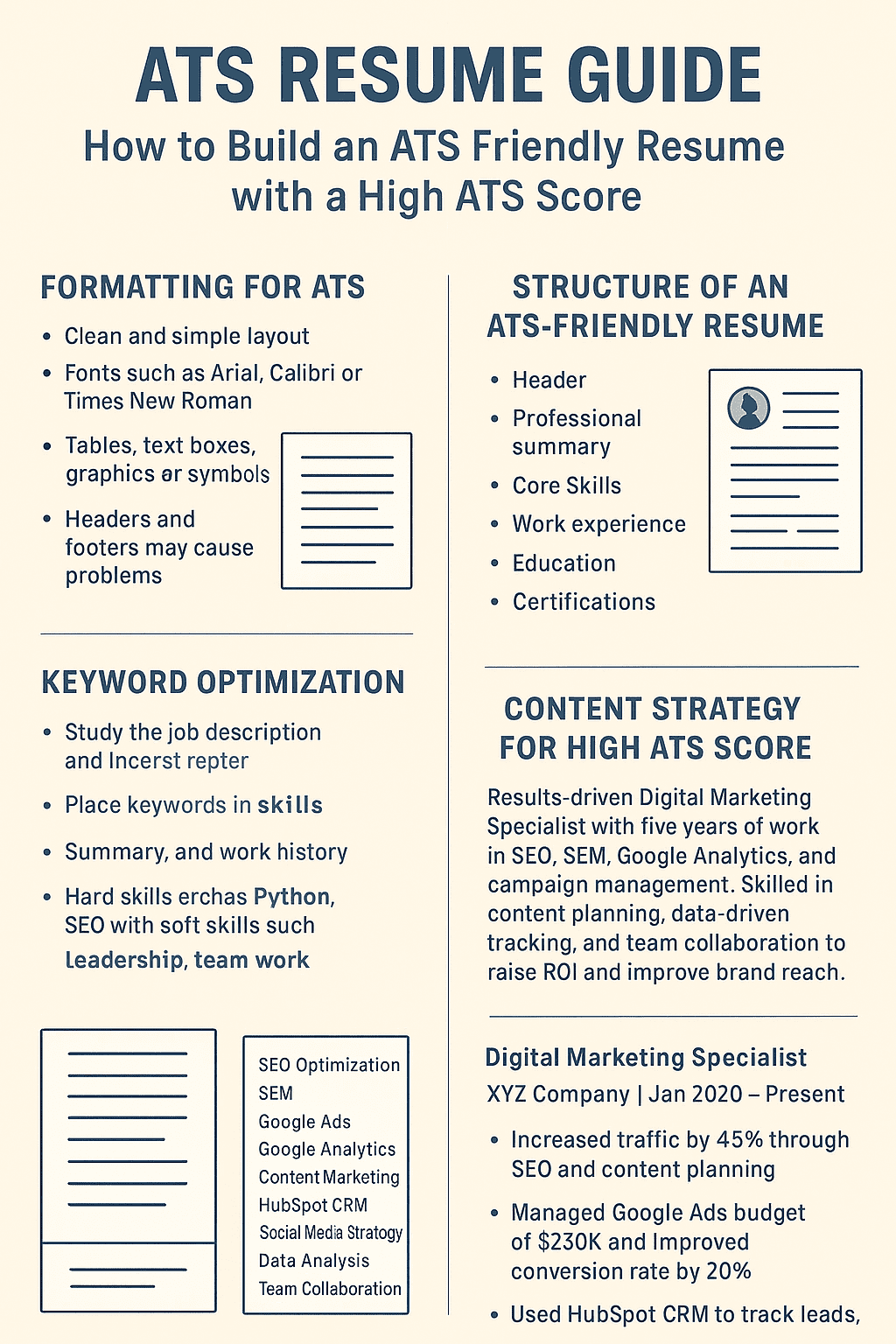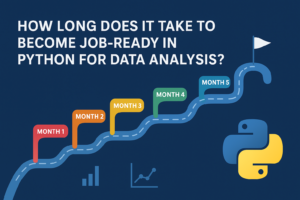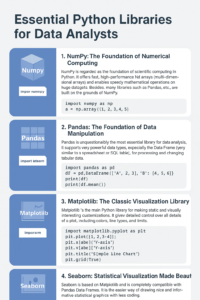An ATS resume can be seen as a document that has to fit both the technical system and the human reader, where we, as applicants, look at the issue of how software checks, filters, and ranks what we put forward before a person even sees it. We know that such systems are data-driven and reactive, and they often scan for structure, keywords, and clarity, while ignoring designs that may seem good to us but cannot be read by the software.
We say that a resume has to have simple formatting where sections are clear, with standard labels like “Experience,” “Education,” and “Skills,” because the system may fail if we make tables, shapes, or images. Fonts that are plain and easy to scan, with points set out as bullets, usually work better than layouts that are complex. If we put in words that match the job description, then the system can mark us as a better fit, since it works on matching data fields, not on personal style. Yet, there is a dilemma. If we go too far toward a system-driven method, then the resume may feel flat, where the human reader later may not see much of our own voice. But if we write with long stories, unusual designs, or special layouts, then the system may not read it at all, and our work may never reach the recruiter. The problem becomes a trade-off: do we stay with plain and machine-readable structure, or do we try to bring in detail and flow for the person who reads it later?
What we can do, then, is check both sides: the quantitative part where the ATS counts words and matches patterns, and the qualitative part where the recruiter sees if our work, skills, and time in projects make sense. If we shape each resume to the role, we raise the chance that the system marks us high, while also leaving space for the person to see value. This choice does not give us one right way, but it opens up a space for us to think on what we want the resume to do, and how far we can go between system needs and human needs.
What Does an ATS Do?
When we look at an Applicant Tracking System, or ATS, we see a tool that companies use to manage the large number of applications that come in for a role. The system has got a manual design in some parts and a data-driven process in others, where it reads, stores, and ranks resumes before they reach a recruiter. The core work of an ATS is to check text in a resume for keywords, skills, job titles, and dates of employment. It uses those data points to compare what is written with what is asked in the job description. If the description says “Python” or “Project Management,” the system will search for that exact phrase, and resumes that fit those words are ranked higher. Resumes without them may be pushed lower, and recruiters may never see them.
We can also say that the ATS helps companies reduce time and manual effort. Instead of reading 500 resumes one by one, the system can filter them in seconds. Reports show that ATS software can cut screening time by more than 60% while reducing human error in early shortlisting. It can track when a person applies, when they move to interview, and where a decision is recorded, so the company has one structured view of the whole hiring process. Yet, there is a problem that we need to think about. The dilemma arises once more from an ethical issue: if the system decides who gets seen and who does not, are we allowing data-driven rules to block people who may have the right skills but write them in a different way? A person may know “data analysis” but write “analyzing data,” and the system may fail to match it. So while ATS brings order, speed, and fewer errors, it may also create a decline in fairness if resumes are filtered out for reasons that are technical, not human.
What an ATS does, then, can be seen from two perspectives. On one side, it gives companies faster hiring, less manual work, and a more organized process. On the other side, it raises questions for us as applicants about how much of hiring is decided by systems and how much is left for recruiters. We do not need to see one side as right and the other as wrong, but we can think about how far we design our resumes for a machine and how far we write them for a person.
How to Write an ATS-Friendly Resume with high ATS Score That Gets Noticed
An ATS-friendly resume can be described as a document that must be read first by a data-driven system before it is reviewed by a person. We see that such systems are used by companies to filter, check, and rank applications. The dilemma arises from a technical issue: if the system does not read what we write in the right way, then the recruiter may never see our work. So we look together at what can be done, what may be avoided, and why certain formats give better results.
1. Formatting for ATS
We begin with the structure, as it can decide if the system reads or rejects. A resume should have a clean and simple layout where fonts such as Arial, Calibri, or Times New Roman are used. Files may be saved as Word (.docx) or as PDF where the employer allows, since some systems still fail to read PDF. Elements like tables, text boxes, graphics, or symbols may cause reading errors, so we avoid them. Headers and footers also create problems, and the system may not record data placed inside them.
2. Structure of an ATS-Friendly Resume
We know the order of parts matters. The header has the name, phone, email, and LinkedIn link. Then we add a professional summary, three or four lines, where keywords from the job are placed. A separate section with “Core Skills” gives ten to fifteen skills in bullet points, where wording matches the description. Work experience is listed in reverse order, and each entry has dates, company name, role, and results that can be measured. Education and certifications come next, with formatting that stays the same across entries. Other parts such as projects, languages, or tools may be added if they help fit the role.
3. Keyword Optimization
The system works on keywords, so we have to study the job description and check what terms repeat. If the job says “Project Management,” then we use that same phrase, not another form. We place keywords in different parts: in skills, in the summary, and in work history. Hard skills such as Python, SEO, or Salesforce may be mixed with soft skills such as leadership or team work. Yet the text should remain natural, where repetition does not look forced.
4. Content Strategy for High ATS Score
A summary can say:
“Results-driven Digital Marketing Specialist with five years of work in SEO, SEM, Google Analytics, and campaign management. Skilled in content planning, data-driven tracking, and team collaboration to raise ROI and improve brand reach.”
An experience entry can be written as:
Digital Marketing Specialist | XYZ Company | Jan 2020 – Present
- Increased traffic by 45% through SEO and content planning.
- Managed Google Ads budget of $250K and improved conversion rate by 20%.
- Used HubSpot CRM to track leads, raising retention by 30%.
A skills section may include:
SEO Optimization | SEM | Google Ads | Google Analytics | Content Marketing | HubSpot CRM | Social Media Strategy | Data Analysis | Team Collaboration
5. Tips to Maximize ATS Score
We can adapt the resume for each job. We can check keywords and put them in multiple places. We can measure results with numbers: percentage growth, cost saved, people managed. We keep headings like “Experience,” “Education,” and “Skills,” since the system looks for these words. Graphics, design features, or extra details may reduce readability, so they are avoided.
Reflective Note
We see that an ATS-friendly resume is a balance. On one side, the system wants structured data with exact words. On the other side, a recruiter may want to see depth, flow, and style. If we adapt too much for the system, we may lose human touch. If we write only for people, the system may fail to read it. The issue is not solved in one way, but it opens for us a space to think about how far we shape content for a machine and how far we shape it for a person.
Next Step – Explore Services with Craze Neurons
When we look at the path to growing our skills, career, or business, we find that it is not only about time or effort but about the ways in which we use guidance, tools, and experience. At Craze Neurons, we offer a set of services that can act as a lens into knowledge, performance, and opportunity. Through these offerings, we can see the depth of learning and the perspective that comes from practical engagement.
- Upskilling Training – We provide hands-on training in Data Science, Python, AI, and related fields. This is a way for us to look at learning from both practical and conceptual perspectives.
👉 Click here to know more: https://wa.me/918368195998?text=I%20want%20to%20Upskill%20with%20Craze%20Neurons - ATS-Friendly Resume – Our team can craft resumes that are optimized for Applicant Tracking Systems (ATS), highlighting skills, experiences, and achievements. This service is available at ₹599, providing a tangible way for us to make first impressions count.
👉 Click here to know more: https://wa.me/918368195998?text=I%20want%20an%20ATS-Friendly%20Resume%20from%20Craze%20Neurons - Web Development – We build responsive, SEO-friendly websites that can be a framework for growth. It is a way for us to put ideas into structure, visibility, and functionality.
👉 Click here to know more: https://wa.me/918368195998?text=I%20want%20a%20Website%20from%20Craze%20Neurons - Android Projects – These are real-time projects designed with the latest tech stack, allowing us to learn by doing. Guided mentorship gives us a chance to look at development from a practical lens and to understand the why behind each decision.
👉 Click here to know more: https://wa.me/918368195998?text=I%20want%20an%20Android%20Project%20with%20Guidance - Digital Marketing – We provide campaigns in SEO, social media, content, and email marketing, which can be used to see our brand’s reach and engagement from a deeper perspective.
👉 Click here to know more: https://wa.me/918368195998?text=I%20want%20Digital%20Marketing%20Support - Research Writing – We deliver plagiarism-free thesis, reports, and papers, which can help us explore knowledge, present ideas, and communicate insight with clarity.
👉 Click here to know more: https://wa.me/918368195998?text=I%20want%20Research%20Writing%20Support
In all these services, we can see that learning, building, promoting, or publishing is not just a task but a process of discovery. It is a way for us to understand, measure, and reflect on what is possible when guidance meets effort.
❓ Frequently Asked Questions (FAQs) – Craze Neurons Services
1. What is included in the Upskilling Training?
We provide hands-on training in Data Science, Python, AI, and allied fields. This allows us to work with concepts and projects, see practical applications, and explore the deeper understanding of each topic.
2. How does the ATS-Friendly Resume service work?
Our team crafts ATS-optimized resumes that highlight skills, experience, and achievements. This is a service priced at ₹599 and acts as a lens to make the first impression clear, measurable, and effective.
3. What kind of websites can Craze Neurons build?
We build responsive and SEO-friendly websites for businesses, personal portfolios, and e-commerce platforms. This enables us to translate ideas into structure, visibility, and functional design.
4. What are the Android Projects about?
We offer real-time Android projects with guided mentorship. This gives us an opportunity to learn by doing, understand development from multiple angles, and apply knowledge in a controlled, real-world context.
5. What does Digital Marketing service include?
Our service covers SEO, social media campaigns, content marketing, and email strategy, allowing us to look at brand growth quantitatively and qualitatively, understanding what works and why.
6. What type of Research Writing do you provide?
We provide plagiarism-free academic and professional content, including thesis, reports, and papers. This allows us to express ideas, support arguments, and explore knowledge with depth and precision.
7. How can I get started with Craze Neurons services?
We can begin by clicking the WhatsApp link for the service we are interested in. This lets us communicate directly with the team and explore the steps together.
8. Can I use multiple services together?
Yes, we can combine training, resume, web, Android, digital marketing, and research services. This allows us to see synergies, plan strategically, and use resources effectively.
9. Is the training suitable for beginners?
Absolutely. The courses are designed for learners at all levels. They allow us to progress step by step, integrate projects, and build confidence alongside skills.
10. How long does it take to complete a service or course?
Duration depends on the service. Training programs vary by course length. Projects may take a few weeks, while resume, website, or research work can often be completed within a few days. This helps us plan, manage, and achieve outcomes efficiently.
Stay Connected with Us
🌐 Website: www.crazeneurons.com
📢 Telegram: https://t.me/cenjob
📸 Instagram: https://www.instagram.com/crazeneurons
💼 LinkedIn: https://www.linkedin.com/company/crazeneurons
▶️ YouTube:https://www.youtube.com/@CrazeNeurons
📲 WhatsApp: +91 83681 95998






